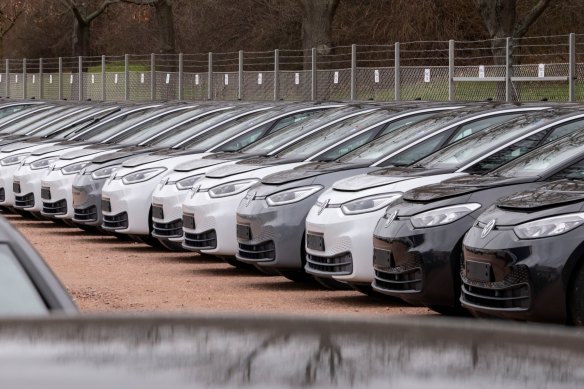This was published 1 year ago
Opinion
Australia is right in the thick of a critical minerals problem
Elizabeth Knight
Business columnistThere is a crisis in critical minerals, one that does not have an easily foreseeable solution. And Australia is in the thick of it.
Last year, the government jumped on the bandwagon highlighting Australia’s resource-blessed position as a home to many of the critical minerals needed for energy transition. Fast-forward to today and there’s carnage in this sector.

Electric vehicles demand is growing, but not fast enough.Credit: AP
Prices are in free fall, the shares of many companies that produce critical minerals have plunged, and those miners without big balance sheets face an existential crisis.
Until last year, many of the world’s largest miners, including BHP and Rio Tinto, had been in a race to build or buy what they describe as future-facing minerals, in a breathless effort that recognised the increasing demand and helped to beef up their environmental bona fides.
And smaller miners and wannabe critical minerals producers popped up like mushrooms seeking to capitalise on the nickel rush or lithium rush.
The party music has now stopped, and the mop-up is ugly.
It’s not just nascent or aspiring companies that are feeling the pinch of the collapse in pricing.
With each day, there is now a fresh slew of bad news from companies that mine or refine (particularly) nickel and lithium.
This ranges from the mothballing of operations and job losses to withdrawal of bank funding.
And it’s not just nascent or aspiring companies that are feeling the pinch of the collapse in pricing. Australia’s richest man, Andrew Forrest, has announced he is about to put his privately owned nickel mines in care and maintenance, and BHP’s nickel refining operations fed by nearby Forrest’s mines are to be mothballed from June.
And only a couple of months ago, Gina Rinehart splashed out $1.3 billion to grab a 19 per cent stake in lithium hopeful Liontown, demonstrating timing that could only be described as impeccably poor but incredibly lucky for suitor Albemarle, which withdrew its takeover bid for Liontown after being thwarted by Rinehart.

Gina Rinehart splashed out $1.3 billion for a 19 per cent stake in lithium hopeful Liontown.Credit: Getty
This week, Liontown revealed it had lost access to a $760 million loan offered only three months ago. The banking syndicate was apparently frightened off after experts Wood Mackenzie released price forecasts which, if correct, would put Liontown under pressure to meet lending covenants.
This is more than a bumpy ride for these commodities, with lithium plunging 90 per cent in a year and nickel falling 40 per cent.
What’s behind what might seem like a counterintuitive collapse is a familiar tale of a free market’s response to fresh demand fundamentals. These minerals are typically used in batteries that will power, among other things, electric vehicles.
Demand has risen sharply, but supply has risen more steeply, and the sting in the tail is that supply is coming from parts of the world that can produce and sell it at a cheaper price, such as Indonesia, Africa and China.
The nickel sector’s problems in particular stem from the explosion of production in Indonesia, whose government has played the game particularly well by demanding that those wanting access to its laterite nickel deposits must build downstream refineries. Indonesia is now producing more than half global supply.
Forrest rightly argues that the price of nickel produced in a more environmentally friendly way should receive a premium over production that depends on cheap coal-fired power, such as the nickel coming out of Indonesia. But this isn’t happening.
There are a couple of ways in which this imbalance between supply and demand can be ameliorated over time.
Lower prices have already begun to remove high-cost supply. The imbalance could also be addressed by increasing demand for EVs.

Fortescue Metals chairman Andrew Forrest.Credit: Bloomberg
And while EV demand has been strong, the cost to the consumer remains significantly higher than the cost of petrol vehicles, which is a disincentive for consumers who have already been assaulted by a cost of living crisis.
There is a self-correcting element in this as well. If cheaper battery materials lead to cheaper electric vehicles, then demand will ultimately catch up.
But this rebalancing could be years away, according to predictions.
In the meantime, Houston, we have a problem.
The Business Briefing newsletter delivers major stories, exclusive coverage and expert opinion. Sign up to get it every weekday morning.